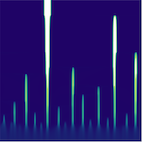Tuesday, 16 March, 2021
Wavelength selection by interrupted coarsening in reaction-diffusion systems
How does a macroscopic length scale emerge as a result of a collective pattern formation process from microscopic dynamics? This question is of great interest in a broad class of far-from-equilibrium systems, including active matter, granular media, and intracellular phase separation. In our work, we study length scale selection in the important class of reaction-diffusion systems dominated by mass-conserving reactions. Our main finding is that wavelength selection in such systems can be understood as a coarsening process that stops at a certain point. Based on this idea, we present a quantitative theory that reveals the physical mechanism of coarsening in mass-conserving reaction-diffusion systems and provides a simple, intuitive criterion for when it stops.
In many pattern-forming processes, a continuously growing macroscopic length scale is observed—a process called coarsening. While coarsening is well understood as minimization of the free energy for systems that are relaxing to thermal equilibrium (e.g. for phase separation in binary mixtures), this reasoning is generally not applicable to non-equilibrium systems. In our manuscript, we present a theory for the coarsening dynamics of the (fully nonlinear) patterns formed by two-component mass-conserving reaction-diffusion (2cMcRD) systems. These non-equilibrium systems are paradigmatic models for cell polarization, describing the interplay between protein attachment to, and detachment from the cell membrane as well as diffusion in the membrane and cytosol. In this biological context, coarsening is important to ensure the selection of a single polarization axis or, specifically for yeast, a “polar cap”.
We present a comprehensive theory for coarsening in 2cMcRD systems, which shows that coarsening is generically uninterrupted in these systems, thus validating a long-standing hypothesis in the field. Our theory is grounded in the insight that coarsening in mass-conserving systems is driven by an instability in the competition for mass between neighbouring high-density domains. The central finding is that coarsening is driven by gradients in a “mass-redistribution potential” that acts analogously to the chemical potential in near-equilibrium phase separation. By using a phase-space analysis, our theory builds on the phase-space geometry of the problem and provides results that are universal, i.e. independent of the concrete mathematical model considered.
By further generalizing this approach to account for weakly broken mass conservation, we reveal the mechanisms underlying interrupted coarsening and domain splitting that lead to stable patterns with a finite length scale. Coarsening is interrupted when the coarsening process is balanced by local production and degradation. In contrast, domain splitting occurs if production and degradation processes trigger a local instability of the pattern.
Importantly, our key insights and findings are transferable to systems with more components and, as we expect, also apply to systems other than reaction-diffusion systems governed by a conservation law. Of particular interest is the generalization of our approach to coarse-grained models of active matter systems. Thus, our theory opens a new avenue to the study of coarsening as well as length-scale selection in far-from-equilibrium systems with a conserved mass.
Fridtjof Brauns, Henrik Weyer, Jacob Halatek, Junghoon Yoon, Erwin Frey
Related Links


